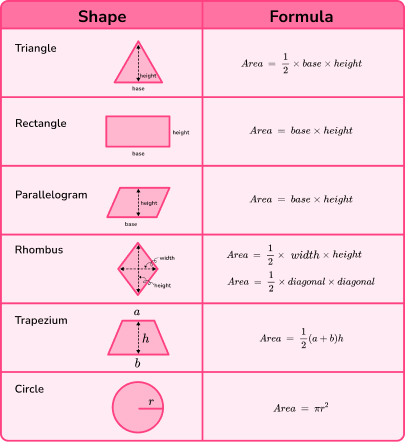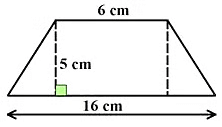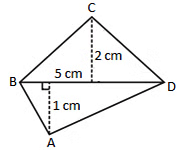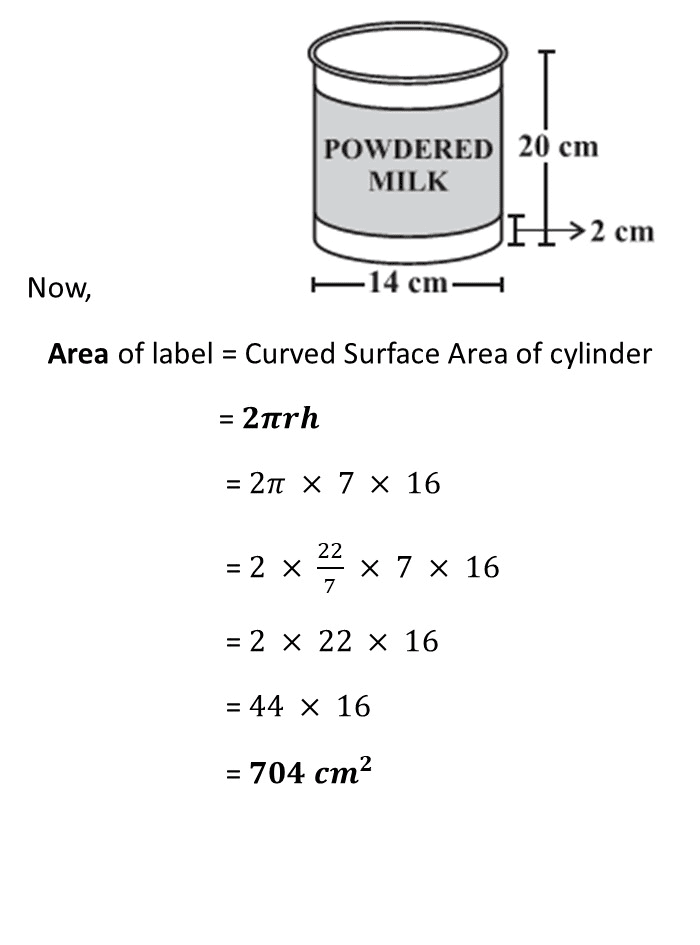Mensuration Chapter Notes | Mathematics (Maths) Class 8 PDF Download
| Table of contents |

|
| Introduction |

|
| Area of a Polygon |

|
| Solid Shapes |

|
| Surface Area Of Cube, Cuboid and Cylinder |

|
| Volume of Cube, Cuboid and Cylinder |

|
| Volume and Capacity |

|
Introduction
In this chapter, we'll tackle calculating the area of complex shapes like Polygons(quadilaterals), and dive into finding the surface area and volume of 3D solids such as cubes, cuboids, and cylinders. Get ready to explore advanced geometry concepts!

Area of a Polygon
To find the area of a quadrilateral, we can split it into triangles and calculate the area of each one. This approach also works for more complex shapes like polygons. Let’s take a look at a pentagon:
By drawing one diagonal, AD, and dropping perpendiculars BF and CG from points B and C, the pentagon ABCDE is divided into four parts. The total area of the pentagon is the sum of the areas of right-angled triangles AFB and CGD, the trapezium BFGC, and the triangle AED. (Can you spot the parallel sides in trapezium BFGC?)
Alternatively, by drawing two diagonals, AC and AD, the pentagon can be split into three triangles. In this case, the total area of the pentagon is the sum of the areas of triangles ABC, ACD, and AED.
This method of breaking down complex shapes into simpler parts makes calculating the area much easier!
There is no particular formula for the area of the polygon so we need to divide it into a possible number of figures like a triangle, rectangle, trapezium and so on. By adding the area of all the split figures we will get the area of the required polygon.
So lets know the formula of areas of all the basic figures with this table.
Let's study in deep trapezium and Rhombus
(i) Area of Trapezium
A trapezium is a quadrilateral whose two sides are parallel. And if its non-parallel sides are equal then it is said to be an isosceles trapezium.

We can find the Area of Trapezium by following these steps:
1. By Splitting the figure
One way to find the Area of trapezium is to divide it into two or three plane figures and then find the area.

In the trapezium ABCD,
It can be divided into two parts i.e. a rectangle and a triangle.
Area of ABCD = Area of ABED + Area of DEC
2. By using formula
Another way is to calculate the area by using formula.

Area of trapezium is half of the product of the summation of the parallel sides and the perpendicular distance between them.
Example: Find the area of the trapezium whose parallel sides are 6 cm and 16 cm, with a height of 5 cm. Calculate the area using both the methods.
Solution:
Splitting the trapezium we get –
Area of the trapezium = Area of rectangle + Area of triangle
= (6 x 5) + (1/2) x 5 x 10
= 30 + 25
= 55 cm2
Remark: We should use the formula most of the time if possible as it is the quick and easy method.
Area of a General Quadrilateral

To find the area of any quadrilateral:
We can divide it into two triangles and then the area can be easily calculated by calculating the area of both the triangles separately.
Area of ABCD = Area of ∆ABC + Area of ∆ACD
= (1/2) × AC × h1 + (1/2) × AC× h2
The formula for the Area of a General Quadrilateral

Where h1 and h2 are the height of both the triangles and d is the length of the common diagonal i.e. AC.
Example: Find the area of quadrilateral ABCD.
Solution:
In the quadrilateral ABCD,
BD is the common diagonal so d = 5 cm.
Height of the two triangles are h1 = 2 cm and h2 = 1 cm.
(ii) Area of Special Quadrilaterals (Rhombus)
A rhombus is a quadrilateral with all the sides are equal and parallel but not making the right angle like in square. Its two diagonals are the perpendicular bisector to each other.

In this also we can split the rhombus into two triangles and can find the area of rhombus easily.
Formula of Area of Rhombus

Area of rhombus is half of the product of its two diagonals.
Example :The floor of a hall is covered with 2500 tiles, each shaped like a rhombus. The diagonals of each rhombus are 50 cm and 35 cm in length. Calculate the total cost of painting the floor if the cost per square meter is ₹5.
Solution:
Example: Find the area of the given octagon.
Solution:
We can divide the given octagon into three parts.
Two trapezium A and B and one rectangle shown by part B.
Two trapezium A and B and one rectangle shown by part B.
Area of A = Area of B = (1/2) × (a + b) × h= (1/2) x (10 + 3) × 2
= 13 cm2.
Area of B = Length x Breadth
= 10 x 3
= 30 cm2.
So, the area of Octagon = 2A + B
= 2 × 13 + 30
= 56 cm2.
Example: Find the area of polygon MNOPQR if MP = 9 cm, MD = 7 cm, MC = 6 cm, MB = 4 cm, MA = 2 cm. NA, OC, QD and RB are perpendiculars to diagonal MP.
Solution:
Example:- The outer dimensions of a rectangular garden are 30 meters by 40 meters, and it contains a central rectangular flower bed with inner dimensions of 20 meters by 30 meters. Calculate the area of the path surrounding the flower bed, if the width of the path is uniform throughout.
Solution:
3. Calculate the area of the path surrounding the flower bed:
Area of the garden−Area of the flower bed=1200m2−600m2=600m2
So, the area of the path surrounding the flower bed is 600m2.
Solid Shapes
The 3-dimensional shapes which occupy some space are called solid shapes.

 Extended vision of cuboid, cube and cylinder
Extended vision of cuboid, cube and cylinder
Surface Area Of Cube, Cuboid and Cylinder
If we draw the net of the solid shape then we can see it’s all the faces clearly and if we add the areas of all the faces then we get the total surface area of that solid shape. The unit of surface area is a square unit.
Lateral or Curved Surface Area
If we leave the top and bottom faces of the solid shape then the area of the rest of the figure is the lateral surface of the shape. The unit of lateral surface area is a square unit.
Surface Area of Cube, Cuboid and Cylinder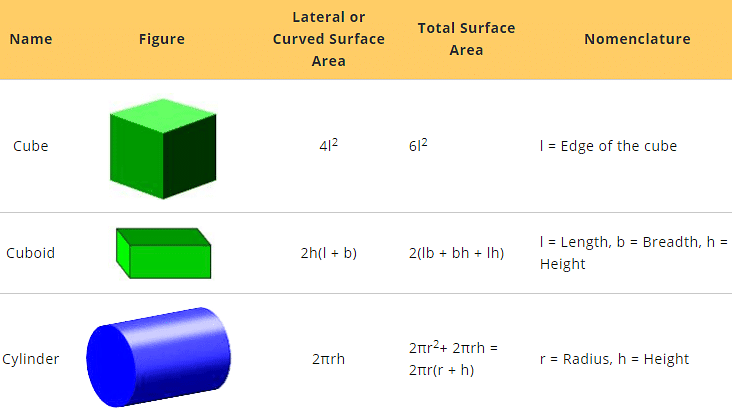
Example: In a building there are 18 cylindrical pillars. The radius of each pillar is 35 cm and height is 5 m. Find the total cost of painting the curved surface area of all pillars at the rate of ₹ 10 per m2 .
Solution:
Radius of cylindrical pillar, r = 35 cm = 0.35 m
height, h = 5 m
curved surface area of a cylinder = 2πrh
curved surface area of a pillar = 2 x 22/7 x 0.35 x 5= 11m2
curved surface area of 18 such pillar = 11m2 × 18 = 198 m2
cost of painting an area of 1 m2 = ₹ 10
Therefore, cost of painting = 198 × 10 = ₹1980
Example: A company packages its milk powder in cylindrical container whose base has a diameter of 14 cm and height 20 cm. Company places a label around the surface of the container (as shown in the figure). If the label is placed 2 cm from top and bottom, what is the area of the label.
Solution:-
Example: Rukhsar painted the exterior of a cabinet with dimensions 1.2 m × 2.5 m × 1.8 m. If she painted all the surfaces except the top and the bottom of the cabinet, what was the total surface area she covered?
Solution:-

a) 12 m²
b) 66 m²
c) 94 m²
d) 72 m²
Volume
Volume is the space occupied by any solid figure i.e. the amount of capacity to carry something is the volume of that solid shape. The unit of volume is a cubic unit.
Volume of Cube, Cuboid and Cylinder
(i) Volume of cuboid
Consider a cuboid having Length, Width and Height to be l, b, h respectively. Then,
The Volume of a cuboid is given by the product of its dimensions.Volume = l × b × h
(ii) Volume of the cube
A Cuboid having all the dimension to be of equal length is known to be a cube. Consider the dimension of a cube to be “a” then the volume of a cube is given as-Volume of a cube = a × a × a= a3
(iii) Volume of a cylinder
A cylinder can be seen as a set of circular disks that are stacked on one another. In order to calculate the space occupied by a cylinder, we calculate the space occupied by each disk and then add them up. Thus, the volume of the cylinder can be given by the product of the area of base and height. There are many other properties of Cylinder.

Consider a cylinder having a base radius of ‘r’ and height to be ‘h,’ thus the volume of a cylinder is given by-Volume of a cylinder = (area of base) × h= (π r2) h= π r2 h
Example: Calculate the radius of the base of a cylindrical container of volume 220 m3. The height of the cylindrical container is 70 m. (Take pi = 22/7)
Solution:
Volume of a cylinder = (area of base) × height of a cylinderArea of base = (Volume of cylinder)/ (height of cylinder) = 220/70 m2
22/7 r2 = 220/70
r2 = 1
r = 1
Example : Calculate the amount of air that can be accumulated in a cube of side 3 m.
Solution: Amount of air that can be accumulated in a cube = capacity of the cube = volume of cube
Volume of cube = a3 = 3 × 3 × 3 = 27 m3
Thus, the amount of air accumulated in a cube of 3 m side = 27 m3
Volume and Capacity
- Volume and capacity are one and the same thing.
- Volume is the amount of space occupied by a shape.
- Capacity is the quantity that a container can hold.
- Capacity can be measured in the form of liters.
We can see the relation between liter and cm3 as,
1 L = 1000 mL
1 mL = 1 cm3,
1 L = 1000 cm3.
Thus, 1 m3 = 1000000 cm3 = 1000 L.
Example: A cuboidal block of silver is 9 cm long, 4 cm broad and 3.5 cm in height. From it, beads of volume 1.5 cm3 each are to be made. Find the number of beads that can be made from the block.
Solution:
Given details are,
Length of a cuboidal block of silver = 9cm
Breadth = 4cm
Height = 3.5cm
Volume of a cuboid = l × b × h
= 9 × 4 × 3.5 = 126cm3
So, Number of beads of volume 1.5cm3 that can be made from the block =
Volume of silver block/volume of one bead
= 126cm3/1.5cm3
= 84 beads
Example:- A village, having a population of 4000, required 150 litres water per head per day. It has a tank which is 20 m long, 15 m broad and 6 m high. For how many days will the water of this tank last?
Solution:
Given details are,
Population of village = 4000
Dimensions of water tank = 20m × 15m × 6m
Water required per head per day = 150 litres
Total requirement of water per day = 150 × 4000 = 600000 litres
Volume of water tank = l × b × h
= 20 × 15 × 6
= 1800m3
= 1800000 litres
We know that,
Number of days water last in the tank = volume of tank / total requirement
= 1800000/600000
= 3 days
∴ Water in the tank last for 3 days.
|
79 videos|408 docs|31 tests
|
FAQs on Mensuration Chapter Notes - Mathematics (Maths) Class 8
| 1. How do you calculate the area of a polygon? |  |
| 2. What is the formula for finding the surface area of a cylinder? |  |
| 3. How is the volume of a cube calculated? |  |
| 4. Can the volume of a cuboid be calculated using the same formula as a cube? |  |
| 5. How can you find the area of a general quadrilateral? |  |

|
Explore Courses for Class 8 exam
|

|
